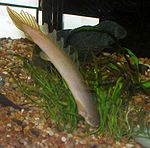- Polypterus senegalus
-
Senegal Bichir 
Scientific classification Kingdom: Animalia Phylum: Chordata Class: Actinopterygii Order: Polypteriformes Family: Polypteridae Genus: Polypterus Species: P. senegalus Binomial name Polypterus senegalus
Cuvier, 1829The Senegal Bichir, Polypterus senegalus, also known as the Gray Bichir and Cuvier's Bichir, is sometimes called the "dinosaur eel" at many local pet chains - a misnomer, as the creature is not an eel. It is a fish, a prototypical species of the Polypterus genus, meaning most of its features are held across the genus.
Contents
Appearance
The body is long and about as deep as it is wide. A serrated dorsal fin runs along most of the body until it meets the caudal fin. The pectoral fins attach just behind and below the gill openings and are the primary means of locomotion, providing a slow, graceful appearance. P. senegalus is smaller than its brethren, reaching about 35.5 cm (14").
The head is small and lizard-like with a gaping mouth and small eyes on either side. Since its eyesight is poor the bichir primarily hunts by smell. External nostrils protrude from the nose of the fish to enable this.The fish has a pair of primitive lungs instead of a swim bladder, allowing it to periodically gulp air from the surface of the water. In the aquarium bichirs can be observed dashing to the surface for this purpose. Provided the skin remains moist, the creature can remain out of the water for near indefinite periods of time.
This bichir's skin serves as a particularly effective armor.[1]
Subspecies
There are believed to be three subspecies of Polypterus senegalus, these are Polypterus senegalus senegalus, Polypterus senegalus meridionalis and a further unnamed species.
P. senegalus senegalus
Maximum size: In wild: 20" Captivity: 12"
Description: Uniform brownish-grey to olive colour on dorsal surface, ventral surface whitish. No banding on adults, very young juveniles show three horizontal bands. Upper jaw slightly longer than lower jaw. 8-11 dorsal finlets.
P. senegalus meridionalis
Maximum size: In the wild: 28" Captivity: 14"
Description: Uniform olive-grey colouration. 9-10 dorsal spines. Jaws appromiately equal length. P. senegalus meridionalis is also thought to be a regional variant of Polypterus senegalus senegalus
Captivity
Bichirs are predatory fish and in captivity will take any live or dead animal that can be swallowed or broken apart and then swallowed. The only thing preventing a bichir from emptying an aquarium of smaller fish is its speed; the pectoral fins only allow for slow cruising, and while it can achieve amazing bursts of speed, it can't catch fish of average speed. Given enough time, any fish that can fit in the bichir's mouth will be eaten; this fish should not be kept with any other fish smaller than three inches.
Bichirs require a lot of floor space; the height of the tank doesn't matter. You should note that since these specimens can grow over 12" long, they should be kept in a 50+ gallon tank. There should be a gap of air in the tank allowing the bichir to gulp air, the tank can't be full of water. Bichirs are escape artists. Without a secure lid on an aquarium, the fish will eventually escape, and go quite a long distance before drying out and dying.
Bichirs will also take dry foods such as shrimp pellets and occasionally cichlid pellets as well as flakes. They will readily accept frozen bloodworms, blackworms, and other frozen foods. They will also accept earthworms. Take care to wash the worms after collecting them, and make sure no pesticides have been recently spread.
See also
External links
- Fish scales may point to armor of the future
- Dinosaur eel inspires bulletproof armor
- Care information for Senegal Bichir at The Aquarium Wiki
References
Categories:- Polypteridae
- Animals described in 1829
Wikimedia Foundation. 2010.

